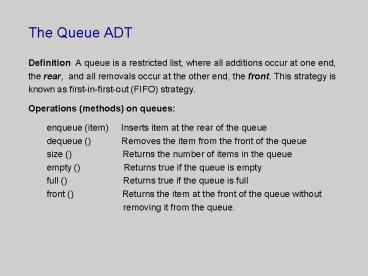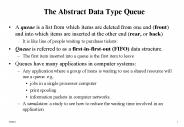The Queue ADT - PowerPoint PPT Presentation
1 / 11
Title:
The Queue ADT
Description:
Here is a more detailed pseudo code description of the radix sort: Input: A queue Q of N items Output: Q sorted in ascending order Algorithm RadixSort (Q, N ... – PowerPoint PPT presentation
Number of Views:14
Avg rating:3.0/5.0
Title: The Queue ADT
1
The Queue ADT
- Definition A queue is a restricted list, where
all additions occur at one end, - the rear, and all removals occur at the other
end, the front. This strategy is - known as first-in-first-out (FIFO) strategy.
- Operations (methods) on queues
- enqueue (item) Inserts item at the rear of
the queue - dequeue () Removes the item from the
front of the queue - size () Returns the number of
items in the queue - empty () Returns true if the
queue is empty - full () Returns true if the
queue is full - front () Returns the item at
the front of the queue without - removing it from
the queue.
2
The Queue Interface in two versions
- version 2
- public interface QueueEx
- public void enqueue (int item) throws
-
QueueFullException - public int dequeue() throws
-
QueueEmptyException - public int size()
- public boolean empty()
- public boolean full()
- public int front() throws QueueEmptyException
- version 1
- public interface Queue
- public void enqueue (int item)
- public int dequeue()
- public int size()
- public boolean empty()
- public boolean full()
- public int front()
3
The Queue ADT -- an array implementation (version
1)
- class QueueADT implements Queue
- final int MAXSIZE 100
- private int size
- private int queueADT
- private int front 0
- private int rear -1
- public QueueADT ()
- size MAXSIZE
- queueADT new intsize
- public QueueADT (int inputsize)
- size inputsize
- queueADT new intsize
- public boolean empty ()
- public void enqueue (int number)
- rear
- queueADTrear number
- public int dequeue ()
- int i queueADTfront
- front
- return i
- public int front ()
- return queueADTfront
- public int size ()
- return (rear 1 - front)
4
The Queue ADT -- an array implementation (version
2)
- class QueueEmptyException extends Exception
- public QueueEmptyException (String message)
- System.out.println (message)
- class QueueFullException extends Exception
- public QueueFullException (String message)
- System.out.println (message)
- class QueueADTEx implements QueueEx
- final int MAXSIZE 100
- private int size
- private int queueADT
- private int front 0
- private int rear -1
- public QueueADTEx ()
- size MAXSIZE
- queueADT new intsize
- public void enqueue (int number) throws
QueueFullException - if (full())
- throw new QueueFullException ("The queue
is full.") - rear
- queueADTrear number
- public int dequeue () throws
QueueEmptyException - if (empty())
- throw new QueueEmptyException ("The queue
is empty.") - int i queueADTfront
- front
- return i
- public int front () throws QueueEmptyException
- if (empty())
- throw new QueueEmptyException ("The queue
is empty.") - return queueADTfront
5
Example application of the Queue ADT using
version 1
- class QueueAppl
- public static void main (String args) throws
IOException - BufferedReader stdin new BufferedReader
(new InputStreamReader(System.in)) - System.out.print ("Enter queue size ")
- System.out.flush()
- int size Integer.parseInt(stdin.readLine())
- QueueADT queue new QueueADT(size)
- int i 2
- while (!queue.full())
- queue.enqueue(i)
- System.out.println (queue.front() " is
the front element.") - i i 2
- System.out.println ("The current queue
contains " queue.size() " elements.")
6
Example application of the Queue ADT using
version 2
- class QueueApplEx
- public static void main (String args) throws
IOException - BufferedReader stdin new BufferedReader
(new InputStreamReader(System.in)) - System.out.print ("Enter queue size ")
- System.out.flush()
- int size Integer.parseInt(stdin.readLine()
) - QueueADTEx queue new QueueADTEx (size)
- int i 2
- try
- for (int j 1 j lt 7 j)
- queue.enqueue(i)
- System.out.println (queue.front() "
is the front item.") - i i 2
- catch (QueueFullException e)
- System.out.println ("The queue is
full.") - catch (QueueEmptyException e)
7
Radix sort another application of the Queue ADT
- Sorting methods which utilize digital properties
of the numbers (keys) in the - sorting process are called radix sorts.
- Example. Consider the list 459 254 472
534 649 239 432 654 477 - Step 1 ordering wrt ones Step 2 ordering
wrt tens Step 3 ordering wrt hundreds - 0 0
0 - 1 1
1 - 2 472 432 2
2 239 254 - 3 3
432 534 239 3
- 4 254 534 654 4 649
4 432 459 472
477 - 5 5
254 654 459 5 534 - 6 6
6 649
654 - 7 477 7
472 477 7 - 8 8
8 - 9 459 649 239 9
9 - After step 1 472 432 254 534 654 477
459 649 239
8
Radix Sort the algorithm
- Consider the following data structures
- a queue for storing the original list and lists
resulting from collecting piles at the end of
each step (call these master lists) - ten queues for storing piles 0 to 9
- Pseudo code description of radix sort at the
idea level - start with the ones digit
- while there is still a digit on which to
classify data do - for each number in the master
list do - add that number to
the appropriate sublist - for each sublist do
- for each number from
the sublist do - remove the
number from the sublist and append it - to a newly
arranged master list
9
Radix Sort the algorithm (cont.)
- Here is a more detailed pseudo code description
of the radix sort - Input A queue Q of N items
- Output Q sorted in ascending order
- Algorithm RadixSort (Q, N)
- digit 1
- while StillNotZero (digit) do
- for (i 1 to 10) do
- create (sublisti)
- while (! empty Q) do
- dequeue (Q, item)
- pile getPile (item, digit) 1
O(N) - enqueue (sublistpile, item)
swaps this outer loop will
execute -
digit times - reinitialize (Q)
- for (j 1 to 10) do
- while (! empty sublist(j)) do
- dequeue (sublistj, item)
O(N) - enqueue (Q, item)
swaps
10
Efficiency of the Radix Sort
- Operations that affects the efficiency of radix
sort the most are dequeue- - enqueue swaps from and to the master list.
Because the outer while-loop - executes C times, and each of the inner loops is
O(N), the total efficiency - of radix sort is O(CN).
- Notes
- 1. If no duplicates are allowed in
the list, we have log10 N lt C for non-negative
integers. - 2. If there is a limit on the number
of digits in the integers being sorted, we have C
lt H log10 N. - Therefore, radix sort is O(N log N)
algorithm if unique values are - sorted otherwise it is O(N) algorithm
with a constant of proportionality, - C, which can be large enough to make C
N gt N logN even for large N. - A disadvantage of radix sort is that it required
a large amount of memory to - keep all of the sub-lists and the master list at
the same time.
11
About the getPile method
- The getPile method must return an appropriate
isolated digit from the number - currently considered. That digit 1 yields the
sublist, where the number is to - be enqueued.
- A possible implementation of the getPile method
is the following - int getPile (int number, int digit)
- return (number (10 digit) / digit)
- Examples number 1234
- digit 100
- (1234 1000) / 100 2
- number 12345
- digit 1
- (12345 10) / 1 5































